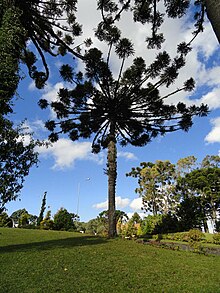Brazilian araucaria
| Araucaria angustifolia | |
|---|---|
 |
|
| Mature tree | |
| Scientific classification | |
| Kingdom: | Plantae |
| Division: | Pinophyta |
| Class: | Pinopsida |
| Order: | Pinales |
| Family: | Araucariaceae |
| Genus: | Araucaria |
| Section: | A. sect. Araucaria |
| Species: | A. angustifolia |
| Binomial name | |
|
Araucaria angustifolia (Bertol.) Kuntze |
|
| Synonyms | |
|
Columbea angustifolia Bertol. (basionym) |
|
Columbea angustifolia Bertol. (basionym)
Araucaria angustifolia, the Paraná pine, Brazilian pine or candelabra tree (pinheiro-do-paraná, araucária or pinheiro brasileiro), is a critically endangered species in the conifer genus Araucaria. Although the common names in various languages refer to the species as a "pine", it is not a true pine.
Covering an original area of 233,000 square kilometres (90,000 sq mi), it has now lost an estimated 97% of its habitat to logging, agriculture, and silviculture. People also eat the fruit and seeds, which reduces propagation. It is therefore listed as critically endangered.
It is native to southern Brazil (also found in high-altitude areas of southern Minas Gerais, southern Rio de Janeiro and in the east and south of São Paulo, but more typically in the states of Paraná, Santa Catarina and Rio Grande do Sul). According to a study made by the Brazilian researcher, Maack, the original area of occurrence represented 36.67% of the Paraná state (73,088 km2 or 28,219 sq mi), 60.13% of the Santa Catarina state (57,332 km2 or 22,136 sq mi), 21.6% of the São Paulo state (53,613 km2 or 20,700 sq mi) and 17.38% of the Rio Grande do Sul state (48,968 km2 or 18,907 sq mi). It is also found in the northeast of Argentina (Misiones and Corrientes) and locally in Paraguay (Alto Paraná), growing in low mountains at altitudes of 500–1,800 metres (1,600–5,900 ft).
It is an evergreen tree growing to 40 m (130 ft) tall and 1 m (3 ft 3 in) diameter at breast height. The leaves are thick, tough and scale like, triangular, 3–6 centimetres (1.2–2.4 in) long, 5–10 millimetres (0.2–0.4 in) broad at the base, and with razor-sharp edges and tip. They persist 10 to 15 years, so cover most of the tree except for the trunk and older branches. It is closely related to Araucaria araucana from further southwest in South America, differing most conspicuously in the narrower leaves.
...
Wikipedia

